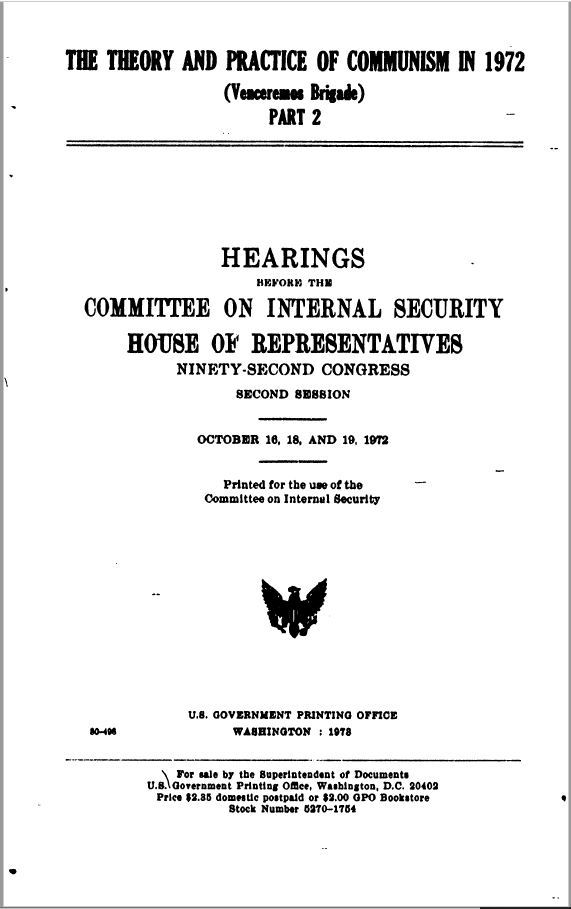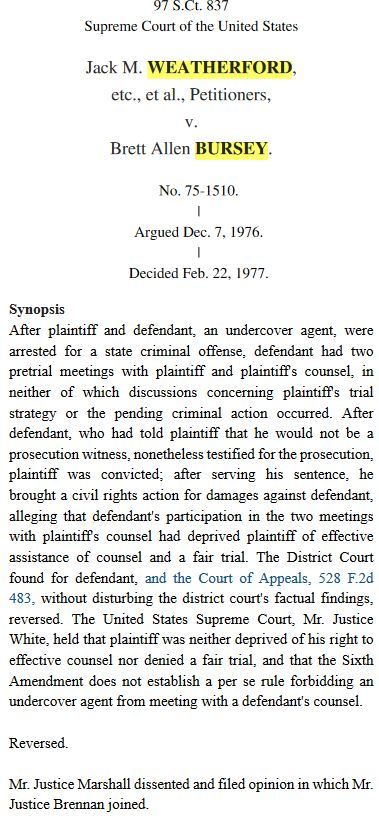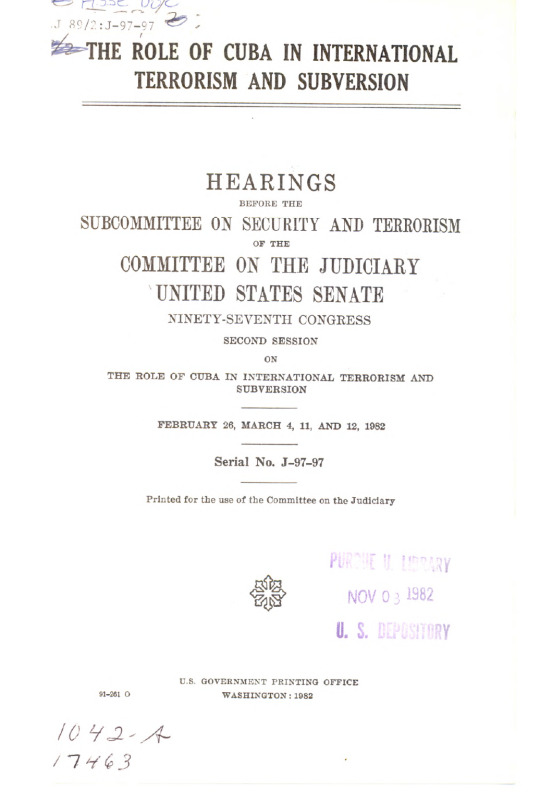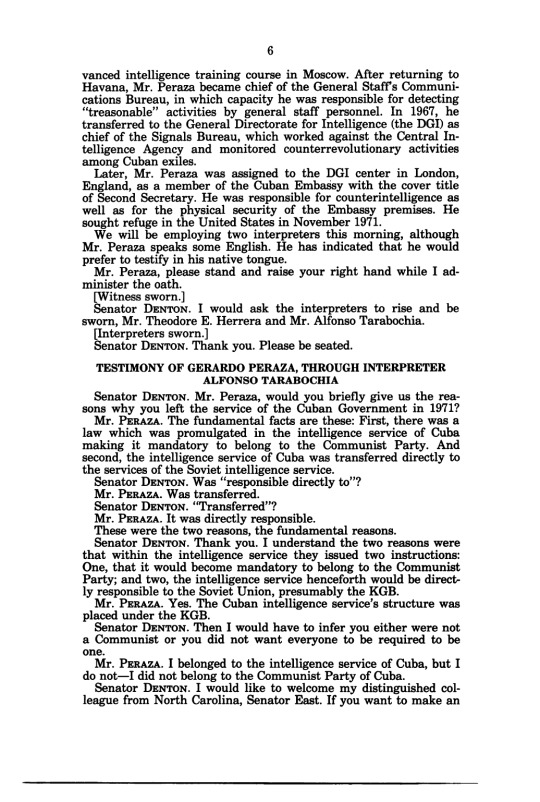Text




Department of Justice. Federal Bureau of Investigation. FBI Annual Report 1970 Fiscal Year. John Edgar Hoover. J 1.14/1:970. Washington, D.C.: Government Printing Office, 1970, https://catalog.hathitrust.org/Record/000521618 (Accessed October 15, 2022).
This annual report provides a curated view of FBI activities pertaining to crime, civil rights, and domestic and foreign intelligence work in the 1970 fiscal year. The document also includes both provocative and stylized photographs depicting crime incidents, FBI employees working onsite or in the field, and FBI campuses.
This is an effective source for aggregating public-facing perceptions and narratives put forth by the FBI regarding a variety of topics, including various politically left or right organizations, as well as its own image as a state of the art, sleek crime fighting force protecting American citizens from threatening communists, criminals, and people of color. However, its major drawbacks are that it is a propagandistic, racist, and fear mongering tool used to manufacture consent for expanding budgets and power within the government and larger public and its findings should be considered with a degree of skepticism. The source employs quantitative data and staged or controversial photos to obscure the FBI’s overreach, civil rights and privacy violations, and violence against politically left organizations—especially those comprised of Black, Indigenous, and other people of color—working to address historic and contemporary US systemic oppression, white supremacy, colonialism, and imperialism. This report’s greatest utility is in its secondary use addressing historical attitudes and views (and within the scope of our project, capturing early views of the Venceremos Brigade), but less so for its intended purpose of accurately reporting its activities and proving its usefulness to the larger American public.
[Image description: front cover of the 1970 Federal Bureau of Investigation (FBI) Annual Report with a blue overlay on top of a background photo of the front of an FBI building (top left); page 27 of the Annual Report featuring the Venceremos Brigade (top right); the introduction page of the annual report with a statement by John Edgar Hoover, director of the FBI (bottom left); a full page photograph of a male FBI laboratory examiner wearing a long trench coat fiddling with some machinery (bottom right).]
1 note
·
View note
Text


1972 Hearing on the Theory and Practice of Communism (Venceremos Brigade) Part 2: Hearings before the Committee on Internal Security, 92nd Cong. (1972) (statement of Manolo Reyes, esteemed member of the Greater Miami Area)
1972 Hearing on the Theory and Practice of Communism (Venceremos Brigade) Part 2: Hearings before the Committee on Internal Security, 92nd Cong. (1972) (statement of Deputy Dwight Douglas Crews and Detective Dennis Dale Gordon)
1972 Hearing on the Theory and Practice of Communism (Venceremos Brigade) Part 2: Hearings before the Committee on Internal Security, 92nd Cong. (1972) (interview with Edward Parker Chatters, Jr., and Evelyn Maddox Chatters)
Accessed through Proquest.
This was the second set of hearings on communism and, more specifically, the actors internally and externally that were pushing to both destabilize the United States as the statement-givers knew it and institute radical social change.
It provides a look at how United States politicians are hearing about the Venceremos Brigade and the language used to talk about communism in the 1970s. It illustrates that many people had a very narrow view of what communism was, equating communism with fascism and anti-imperialism with communism.
Manolo Reyes, in particular, had a strong and harsh anti-communist sentiment, going so far as to describe the Venceremos Brigade as a Trojan Horse that would help normalize communist sentiment in the United States using radical U.S. citizens as the conduit. It was not Cuban influence in the United States that Manolo warned against, but rather Soviet influence that was using Cuba as a cover and disguise to influence the United States.
I believe that this is an effective source for looking at how some people and how many legislators in the United States viewed Communism in the 1970s. The biggest drawbacks to this source are how negative the testimonials are, the implicit patriotism, and the confusion by all parties involved in this hearing with conflating communism and fascism and conflating anti-imperialism with communism. I think that it is effective at convincing readers, unless they start reading with lots of prior knowledge about Cuba and Communism in the 1970s, that Cuba and Fidel Castro were terrible and that the Venceremos Brigade was an extension of that evil into the United States working to persuade the American populace away from a patriotic view. This hearing does a really good job at highlighting the anti-Cuban and anti-Communist sentiments at the time, as well as clarifying how information about the Venceremos Brigade can be framed in a purely negative light focused on ulterior motives.
[Image description: Two images from the printed transcript of the 1972 Hearing on the Theory and Practice of Communism (Venceremos Brigade) Part 2: Hearings before the Committee on Internal Security. The first image is the cover page for the document, listing the title, the congress that heard it, and the dates the hearings took place. The second image is a black and white image of a shadowed horse standing on a black pedestal in front of a white background. The phrase Venceremos Brigade is listed on the pedestal and the acronym VB is printed on the horse's flank, both in white.]
0 notes
Text


Weatherford v. Bursey, 9 and 12 (S.Ct. Appellate Brief October 20, 1976).
AND
Weatherford v. Bursey, (97 S.Ct. December 2nd 1975)
This trial contains a collection of testimony by a man named Jack M. Weatherford who went to school at University of South Carolina and, while he was there, acted as an undercover agent for the South Carolina Law Enforcement Division. Throughout the few years he was acting in this capacity, he infiltrated and co-led a radical group on campus and applied for membership in the Venceremos Brigade who "appeared to be more radical, say, than a lot of other radicals" (pp. 12). The defendant in the case, Brett Allen Bursey, claims that Weatherford was one of his closest friends and that Weatherford participated in and instigated an act of destruction of property on campus. Throughout the legal process, Weatherford deliberately created a ruse where he and Bursey were co-defendants in the trial for this campus destruction only to reveal himself as a witness against Bursey on the first day of trial.
This trial went to the Supreme Court, who reversed the Court of Appeals decision that Bursey's rights were violated. The Supreme Court, through this case, cements the fact that undercover agents have a significant amount of power to lie and manipulate the defendant and his attorney with no legal repercussions. This brief from the U.S. Court of Appeals brings to light some of the tactics used to surveil groups on the left and some of the ideologies held by the military arm of the state.
One quote, from the police handler for Weatherford, encapsulates this really well: “Well, if I get information a man is going to rob a safe, if I would instruct him to stop it, I mean, we never would have a violation and all the thieves and crooks would be going wild; so you catch them and take them into the courtroom” (pp. 9). Rather than methods of prevention, the police step in to punish once bad actions are taken.
It is an effective source because the writers have taken previous testimony and put the information under unambiguous headings to create a narrative where the secret agent is clearly in the wrong and was doing morally dubious actions. Nevertheless, the Supreme Court does not find that any legal wrongdoings have been done. Its primary drawback is that it does not reach far enough to denounce the practices used by Weatherford and his handler. While it narratively paints Weatherford as unreliable and it suggests that it is an injustice that he is getting away with all of this, there is no strong language or purposeful admission that it should not be done in the future. That said, given it is a legal document, that language and strong denunciation is not expected. It is refreshing to see the court write a secret agent in a negative light, despite the outcome, and assert that his identity as a secret agent was not required to be kept hidden as long as it was, even if it certainly does not go far enough to look at the harms the secret agent posed to groups at USC that, by Weatherford’s own admission, were painting peace signs on buildings.
[Image description: two front covers of different legal documents. The first is the front page from the U.S. Court of Appeals Weatherford v. Bursey brief. The second is from the Supreme Court's ruling of Weatherford v. Bursey.]
0 notes
Text




United States. Congress. Senate. Committee on the Judiciary. Subcommittee on Security and Terrorism. The Role of Cuba in International Terrorism and Subversion: Hearings before the Subcommittee on Security and Terrorism of the Committee on the Judiciary, United States Senate, Ninety-Seventh Congress, Second Session, on the Role of Cuba in International Terrorism and Subversion, February 26, March 4, 11, and 12, 1982. Washington, D.C.: Government Printing Office, 1982, https://catalog.hathitrust.org/Record/011342154 (Accessed November 10, 2022).
This publication consists of the transcripts and supplemental materials for a Senate subcommittee hearing on what it considers Cuba’s role in “international terrorism and subversion,” featuring testimony by Gerardo Peraza, the second secretary of the Cuban Embassy in London and allegedly a former member of the Cuban intelligence service, as well as statements and articles from Daniel James, an independent journalist, with extensive connections to the CIA, FBI, and their assets.
This is an effective source for insight into how narratives were presented and understood by the US Senate regarding the Cuban communist government and its connection to the Venceremos Brigade. The main limitations of the document are its reliance on the testimony and writings of CIA/FBI affiliated, conservative journalist, Daniel James, without any substantial context for this or any real interrogation of his background and connections, which would confuse readers attempting to assess the credibility of witnesses and testimony. The narrative put forth by both Peraza and James paint the Venceremos Brigade as an extension of Cuban and Soviet intelligence or a sort of “front group,” devoid of agency as American citizens to express their discontent with violent economic sanctions and limiting travel restrictions put forth by the US government against Cuba. This source’s utility lies in its secondary use capturing larger meta narratives about the US government’s portrayal of Cuba, its government, and communism broadly.
Additional Commentary
[Image description: front cover of The Role of Cuba in International Terrorism and Subversion: Hearings before the Subcommittee on Security and Terrorism of the Committee on the Judiciary document, and three excerpts containing the testimony or statements of Gerardo Peraza and Daniel James (pages 6, 15, and 181).]
0 notes
Text
Additional Commentary
Pertaining to: The Role of Cuba in International Terrorism and Subversion Hearings
To further contextualize the narrative that the Venceremos Brigade was no more than an extension of Cuban and Soviet intelligence agencies without its own autonomy , I looked further into the one of the two relevant subjects, Daniel James, who provided statements during or for the Senate’s Hearings on The Role of Cuba in International Terrorism and Subversion. In the document, James is identified as “a journalist and specialist in Latin American Affairs” (The Role of Cuba in International Terrorism and Subversion, p. 142). I initially found James’ 1994 obituary, which notes him as a key figure “to have helped persuade former Haitian military strongman Raoul Cedras to invite Carter to Haiti, a mission that helped pave the way for the peaceful landing of U.S. troops.” Raoul Cédras, was a CIA-affiliated military officer who enacted a coup d'etat against the democratically elected Haitian President Jean-Bertrand Aristide. A subsequent search of James’ name on Mary Ferrell featured a variety of hits featuring him in FBI and CIA records in connection with other intelligence agency-connected individuals including, but not limited to Jose Pepin Bosch (NARA Record Number: 124-10290-10081), Paul Bethel, and Andrew St. George (FBI 62-109060 JFK HQ File, Section 24). James' role as the executive secretary for the Citizens Committee to Free Cuba also connected him to Ernest Cuneo, Virginia Prewett, and Paul Bethel (Fonzi, p. 321). Bethel and Cuneo additionally have World War II connections to the Office of Strategic Services (OSS), the precursor to the CIA. James, Bethel, Cuneo, and Prewett all had some connection to John F. Kennedy’s assassination, laying blame on Fidel Castro for the act. All to say that James’ connections alone should rouse scrutiny of his assertions.
Unfortunately there was little information available about Gerardo Peraza, the former second secretary of the Cuban Embassy in London and allegedly a former member of the Cuban intelligence service (The Role of Cuba in International Terrorism and Subversion, p. 6), outside some of the same repeated information from these hearings in various blogs or articles. None of the databases I consult for declassified documents (The Black Vault or Mary Ferrell) turned up any results for his name, which could mean records pertaining to him from US intelligence agencies have not been released yet or are redacted.
0 notes
Text


United States. Congress. Senate. Committee on Foreign Relations. Subcommittee on Western Hemisphere and Peace Corps Affairs. Cuban Liberty and Democratic Solidarity Act: hearings before the Subcommittee on Western Hemisphere and Peace Corps Affairs of the Committee on Foreign Relations, United States Senate, One Hundred Fourth Congress, first session, May 22 and June 14, 1995. Washington, D.C.: Government Printing Office, 1995, https://catalog.hathitrust.org/Record/007608566 (Accessed November 26, 2022).
This publication consists of testimony, statements, letters and other supplementary documents provided by politicians, business people, public servants, and other citizens in support of passing the Cuban Liberty and Democratic Solidarity (LIBERTAD) Act of 1996 (H.R.927), otherwise known as the Helms–Burton Act. This act, which ultimately passed, focused on strengthening and extending sanctions against Cuba (including allowing the Legislative Branch to override any future Executive efforts to end the embargo, although this power broadly was previously ruled unconstitutional), further isolating the island nation internationally, and financing efforts to interfere with a sovereign country to change its government.
The scope of this project led to a focus on the statement provided by Dr. Emilio-Adolfo Rivero, identified as a “Cuban-American attorney, journalist, [and] former political prisoner in Cuba” from 1961-1979 in the document. Rivero identifies members of the Venceremos Brigade among “Americans trained in Cuba” who contributed to “public disorders that took place in the US during the years of the Vietnam War,” which is portrayed as a negative action that he sees as the Cuban government “demoralizing and weakening American youth” (pp. 328). What the document fails to contextualize is that Rivero was a CIA asset (cryptonym AMPANIC-7) who had been affiliated with the agency since April 1960, prior to his arrest, and whose intentions were to “[mount] sabotage missions… and [assassinate] prominent Cuban Communist members in the Castro entourage.” This fact should draw into question the validity of Rivero’s claims. Considering the eventual passage of the Helms–Burton Act, this source was effective in generating congressional consent to further economically strangle Cuba and weaken future administration’s abilities to end the violent blockade of the island. It also serves a useful secondary purpose of compiling continued anti-communist and dehumanizing narratives about Cuba during the 1990s.
[Image description: front cover of Cuban Liberty and Democratic Solidarity Act: hearings before the Subcommittee on Western Hemisphere and Peace Corps Affairs of the Committee on Foreign Relations document, and one excerpt containing the statement of CIA asset Dr. Emilio-Adolfo Rivero (pages 208).]
0 notes
Text
Conclusion
We have connected and critically analyzed several documents shedding light on US government-endorsed narratives about the Venceremos Brigade (VB) throughout the 53 years since its founding. From its division from Students for a Democratic Society (SDS) in 1969, the VB was on the United States’ radar as a potential threat. Its name showed up in FBI Annual Reports, Senate and House hearings, legal cases, and other documents kept under a tight wrap until FOIA requests and time pulled the records out into the open. US intelligence agencies and police forces have been surveilling politically left organizations including the VB (NARA Record Number: 124-10274-10127; 104-10064-10003) to crush organized solidarity and efforts to address inequities and oppression that go against the state’s white supremacist capitalist interests. There is power in the knowledge and imagining of alternative forms of society and governance that the ruling class were and are still afraid of to this day. The language around the VB and communism has changed over the last 50 years, but core tenants of these demonizing sentiments and distrust remain prevalent today. One doesn’t have to look far to see recent attacks and slander against then Vice President shortlist consideration, now incoming Los Angeles mayor, Karen Bass, for her time as a VB organizer and participant in the 1970s. Same patterns, somewhat different playbook.
The blockade against and travel restrictions to Cuba persist, and yet the VB continues its brigading and educational work, 53 years after its inception, to practice solidarity with the Cuban people and express their rights as U.S. citizens to travel free of US government obstacles. ¡Cuba sí! ¡Bloqueo no! End the embargo against Cuba.
0 notes
Text
Venceremos Brigade: A Case Study in Anti-Communist Narratives
Final Project for LIS 526 Government Information: Production and Access at the University of Washington.
Created by: Gabrielle Garcia and Emilie Hoy, Master of Library & Information Science '24, Fall 2022.
Navigation
All theme and page codes attributed to the creators linked below. Customizing and optimizing code for this project done by Gabrielle Garcia.
Home (theme code by engelthm)
Contact
Abstract / Overview (contains bibliography) (page code by aureacor)
Timeline (page code by odeysseus)
Documents / Resources (page code by pohroro)
Gov Pubs Finds
Conclusion Post
5 Annotated Citations of Government Documents
FBI Annual Report 1970 Fiscal Year
1972 Hearing on the Theory and Practice of Communism (Venceremos Brigade) Part 2
Weatherford v. Bursey (Supreme Court 1976)
The Role of Cuba in International Terrorism and Subversion Hearings, 1982 (Additional Commentary)
Cuba Liberty and Democratic Solidarity Act Hearings, 1995
0 notes